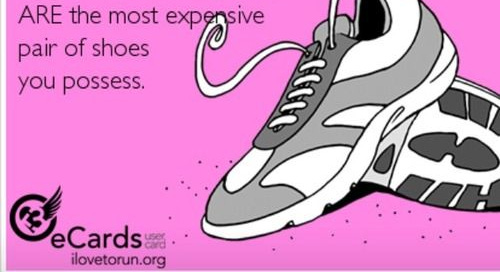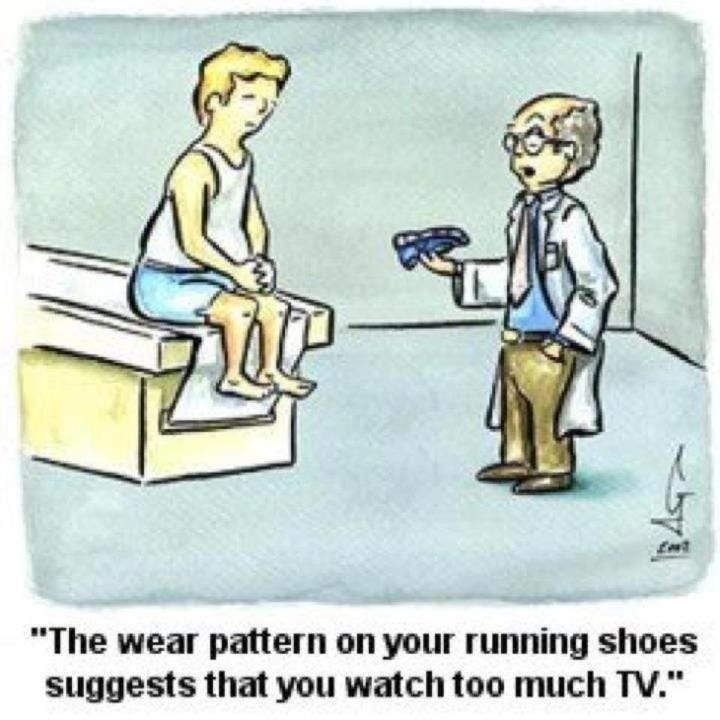Welcome,
I am typing this from New Jersey just before returning to the desert. One of my goals for 2023 was to take a weekend trip somewhere. Just to say that I did it. My coworkers suggested I go to the airport and say give me a ticket on your cheapest flight out...but alas, I am not that brave!
It made sense to head back to NJ for the Broad Street 10 miler. That's my *favorite* Philadelphia race, and it's always a lot of fun. I always wish I had more time, but it was great to see a few people and hang out with my family.
Anyway, one of the most common questions in my email inbox is:
Do running shoes cause injury?
Short Answer:
The type of shoes, whether size, fit, or type of shoe, can cause injury, but running shoes generally don't cause injury. Running shoes are typically just a piece of the puzzle in why you might have gotten injured—other pieces include mileage, running gait, and nutrition.
If you are running in the wrong shoe, for YOU, it might work weaker parts of your body. If those weaker parts are stressed too much, you'll end up with an injury.
Long Answer:
How is Research Done on Running Shoes and Injury?
When research is done with anything, it's done on study participants. We know every foot is different, and you should only care about your own two feet.
There are hundreds of types of shoes. There are zero drop, 12 mm drop, high cushion, lower cushion, carbon fiber plate, nylon plate, wide, narrow...as you can see, the list is truly endless. While many people believe Hoka is a "maximalist" shoe, most Hoka models have a 5 mm stack height, whereas most Brooks have 11, and many Saucony have 8 mm. Altra and Topo both have zero drop models.
To truly answer the question: Do running shoes cause injury, we first need to study each type of shoe.
We would also need to understand how each shoe works with each gait and specifically with your gait. This means every single runner would have to try every single running shoe. So it's next to impossible to say without a doubt running shoes do or don't cause injury.
Every runner has specific shoes that might make them more susceptible to injury. For me, I supinate, so adding a stability shoe would stress my IT bands, knees, or even quads. Likely I'd have some form of injury if I consistently ran in a stability shoe.
Most running shoe studies focus on one shoe design component, such as the heel-to-toe drop or the amount of cushion. Instead of "Do running shoes cause injury," they answer,
Does lower stack height in a running shoe cause injury?
Does the softness of the cushion cause injury?”
These studies don't (and can't) consider every single factor. Two shoes could be similar in cushion and heel-to-toe drop but vary in weight or heel-to-toe drop. For instance, the ASICS Nimbus and Hoka Clifton both have about the same amount of cushion. Studies on each shoe causing injury would turn out differently. The ASICS Nimbus has an 8 mm drop, whereas the Hoka Clifton has a 5 mm drop. The Hoka Clifton is also much lighter, and the fit of the Clifton is wider. The two shoes might be similar in cushion level, but they are completely different in most other ways.
How Should You Pick Out a Shoe?
If you've never been fitted for a running shoe, go to a local running store to get fitted. They'll look at your feet and find the best shoes for you. You might be surprised to learn you're a completely different size or like a brand you thought you hated.
Let comfort be your key. If a running shoe feels good, it's probably good for you. It probably won't feel good later if it doesn't feel good out of the box. You don't need to break in a running shoe, and anyone who tells you that isn't knowledgeable or just trying to sell you a shoe.
What about carbon fiber-plated shoes?
Finally, carbon-plated shoes are in their own category. More and more research is coming out that carbon-plated shoes may actually cause injuries. Like any running shoe, they aren't magical and won’t work for everyone. Some people will get hurt running in them. I know I have!
I wrote about why the Next% doesn't work for me, and I've generally been a "non-responder" to carbon plates. Like the five-finger running shoes, we will see more research that carbon-plated shoes are not designed for everyone. They were first created for elite runners with ideal form.
Generally, carbon fiber plates accentuate any biomechanical flaws you might have, and those tiny repetitive motions can end in injury. Research has come out about them contributing to bone stress injuries, Achilles problems, and ankle problems (probably more).
Conclusion:
Don't think of running shoes as a magical way to stay healthy or the singular problem to an injury. There is no "best shoe for plantar fasciitis." Instead, think of them as a piece of the puzzle that helps you avoid injury. Most running injuries start from a repetitive motion that isn't working for you, whether that is running too much without rest or running miles in a shoe that isn't working.
Eventually, the repetitive motion becomes too much for your body to handle and breaks. There is much more to running and your running journey, including strength training, rest and recovery, diet, and sleep.
Shoes are your most important gear, so make sure they feel good and are the right ones for you.
What is Keeping Me Entertained?
Zensah Compression Sleeve Review
Choosing to Run by Des Linden: I read Choosing to Run in just a couple of sittings. It's that good.
Hyponatremia Causes and Treatment in Athletes: Overhydration can be a serious issue for runners and athletes in general.
Who Will Run the World Championships Marathon for the U.S. This Summer?
Podcast: I'll have another: Reid Buchanan – Redefining the Purpose of Running
You Can Follow me on:







Have you tried, or heard much about the Speedland shoes? I don't know why my first thoughts are "For that price, they have to be amazing!" Lol